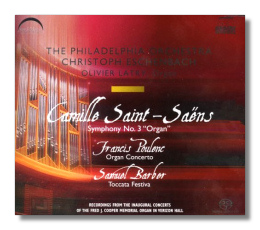
The Internet's Premier Classical Music Source
Related Links
-
Barber Reviews
Poulenc Reviews
Saint-Saëns Reviews - Latest Reviews
- More Reviews
-
By Composer
-
Collections
DVD & Blu-ray
Books
Concert Reviews
Articles/Interviews
Software
Audio
Search Amazon
Recommended Links
Site News
 SACD Review
SACD Review
Inaugural Concerts of the Fred J. Cooper Memorial Organ

At the Kimmel Center, Philadelphia
- Samuel Barber: Toccata Festiva, Op. 36
- Francis Poulenc: Concerto for Organ, Strings & Timpani
- Camille Saint-Saëns: Symphony #3 in C minor, Op. 78 "Organ"
Olivier Latry, organ
Philadelphia Orchestra/Christoph Eschenbach
Ondine 1094-5 Hybrid Multichannel SACD 79:11
My friend Bill (not his real name!) is the only person I know who was pulled over by the police for playing classical music too loudly in his car. (I don't think the cops knew what to make of it.) The offending music just happened to be Saint-Saëns' "Organ" Symphony. This was several years ago, so this new recording, which dates from May 2006, was not the culprit. It certainly deserves to have been, though, because Ondine's engineering, combined with the generally excellent performances, could send sonic shock waves through not just one car, but through a whole rush hour.
The Poulenc and the Saint-Saëns have been paired together a few times, and the Barber makes a worthwhile addition, although it is made of thinner stuff than its companions. Furthermore, all of these works are associated with the Philadelphia Orchestra, and its former Music Director Eugene Ormandy. There are at least four different Ormandy/Philadelphia recordings of the Saint-Saëns (E. Power Biggs mono, E. Power Biggs stereo, Virgil Fox quad, and Michael Murray digital), and they also recorded the Barber and the Poulenc with Biggs around 1960. I believe that the Barber was commissioned to celebrate the installation of a new organ in Philadelphia's Academy of Music. This new live CD celebrates yet another new organ for the Philadelphians: the Fred J. Cooper Memorial Organ in Verizon Hall. Needless to say, this is not one of those recordings in which the orchestra and the organ have been recorded separately, and mixed together later on. The audience voices its noisy approval after all three works, but is quiet otherwise.
It is a shame that Eschenbach will be leaving Philadelphia in 2008, not least because of the recordings that have been released during his tenure. One in particular, a Mahler Sixth (Ondine 1084-5D) is definitely at the very top of the heap in terms of engineering, and the interpretation and playing are more than respectable as well. For some, Mahler is a taste they never acquired, but the Saint-Saëns is very digestible (perhaps too digestible), and the Poulenc, which vacillates between morbidity and hilarity, is hard not to enjoy, even at first hearing. Eschenbach does nothing particularly outré with either of them, and the Barber is given a good work-out… almost good enough to hide the fact that this is one of Barber's weaker works. There's much about Eschenbach's Saint-Saëns, as a matter of fact, that reminds me of Ormandy's second recording with Biggs, although Eschenbach's tempo is slower in the second half of the first movement (to good effect) and somewhat brisker in the second movement. My favorite recording of the Poulenc remains the one conducted by Georges Prêtre, with organist Maurice Duruflé. Eschenbach's is better played, but it is a little business-like, and a little too unwilling to indulge the music's manic-depressive moods. In other words, it is not French enough. Still, the music's ability to amuse and appall remains intact, and the Orchestra's new organ is shown off to superb effect here.
This release is recommended first for the sonics, and second for the Saint-Saëns. One hopes that Eschenbach's last season with the orchestra will not be neglected by Ondine. The label's presentation includes a thick booklet, separately housed from the jewel box in a slip case. Vive la France!
Copyright © 2007, Steve Schwartz




















